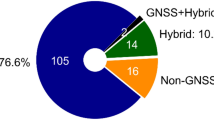Abstract.
The analysis of lunar laser ranging (LLR) data enables the determination of many parameters of the Earth–Moon system, such as lunar gravity coefficients, reflector and station coordinates which contribute to the realisation of the International Terrestrial Reference Frame 2000 (ITRF 2000), Earth orientation parameters [EOPs, which contribute to the global EOP solutions at the International Earth Rotation Service (IERS)] or quantities which parameterise relativistic effects in the solar system. The big advantage of LLR is the long time span of lunar observations (1970–2000). The accuracy of the normal points nowadays is about 1 cm.
The capability of LLR to determine tidal parameters is investigated. In principle, it could be assumed that LLR would contribute greatly to the investigation of tidal effects, because the Moon is the most important tide-generating body. In this respect some special topics such as treatment of the permanent tide and the effect of atmospheric loading are addressed and results for the tidal parameters h 2 and l 2 as well as values for the eight main tides are given.
Similar content being viewed by others
Author information
Authors and Affiliations
Additional information
Received: 14 August 2000 / Accepted: 15 October 2001
Rights and permissions
About this article
Cite this article
Müller, J., Tesmer, V. Investigation of tidal effects in lunar laser ranging. Journal of Geodesy 76, 232–237 (2002). https://doi.org/10.1007/s00190-001-0239-0
Issue Date:
DOI: https://doi.org/10.1007/s00190-001-0239-0




